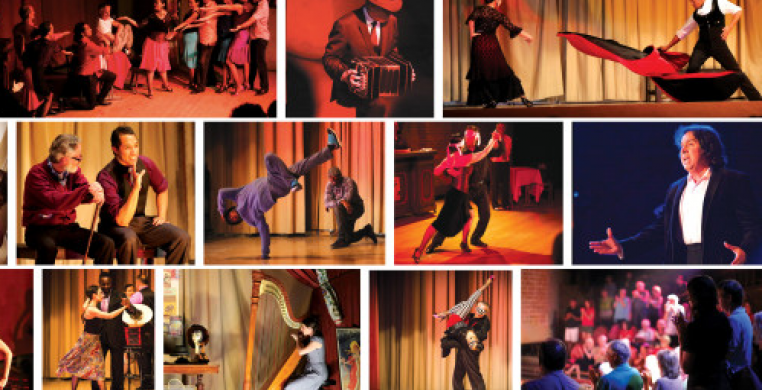“Attention Passengers!” Who hasn’t heard those words with a sense of dread? For Tango 21 Dance Theater, flight delays become the dominant metaphor for “Feathers,” the company’s third multi-disciplinary tango production (August 19-21, Ruth Page Center for the Arts).
Cleanly staged and rich in concept, this flight never fully takes off, but what it promises--combining the drama and passion of the tango dance form with scripted story, exotic bird masks, and live instrumental and vocal music (Samuel Ocean on piano and Ann Cusack on accordion)--is well worth developing to its creative potential.
“Feathers” depicts passengers stranded at O’Hare Airport’s fictional gate T21 waiting overnight to board their delayed flight to Argentina. One dose of generic airport choreography, complete with rolling suitcases and a cross-section of travel types hustling to nowhere, gave a clear sense of place, but that wore thin as it repeated periodically to no particular dramatic purpose or build.
Individual stories of three characters--Paloma (Rose Guccione), the closet opera singer turned airport janitress; Robin (Stephanie Mattos), the bird enthusiast; and Kim (Winita Lau), the flight attendant--converge in the loosely-structured plot. It is, in the end, Paloma’s story that carries the message: like birds, we must set ourselves free and fly where our hearts take us.
Birds, bird masks, and bird magic orchestrated by choreographer and company director Jorge Niedas, playing the mystical non-speaking role of The Messenger, intrigue in assigning bird identities to each of the individuals. This theme, somewhat confusing and merely suggestive of what it could become, is not adequately developed in scenes or choreography, but begs to be more fully explored. This is especially so in light of the last scene in which the entire company transforms into birds, complete with sleeves made of feathers, as they are finally allowed to board their flight. Choreographically simplistic and repetitive, this great idea met the performers at their collective ability levels, but why not aim higher?
To their credit, the dancer/actors delivered their lines clearly, with a naturalness that made them appealing and believable. Ms. Guccione brought humor and warmth to the sympathetic role of Paloma, taking a couple of star turns with her opera-sized voice, and Ms. Mattos as the non-dancing Stephanie brightened the stage in Act Two with a beautifully-sung solo ballad, “Who Knows Where The Time Goes.”
One would expect the tango’s intricate footwork, Latin rhythms, and dramatic interaction between its dance partners to be the structural armature supporting the whole--story, characters, circumstances, obstacles, relationships. Strangely, the dancing in “Feathers” is more of a decorative tangent, with academic interludes of tango duets and ensemble sequences interspersed between staged scenes of spoken dialog. The dance segments were simple enough for the Tango 21 ensemble to execute proficiently, but tended to be repetitive and not choreographically substantial enough to either command visual interest or further the development of character and story narrative. One would have wished for the dancing to excite, to fill the stage with energy, technical virtuosity, and vigor, to take the tango to explosive heights yet unexplored. At this early juncture in its history, Tango 21 Dance Theater is a young company still in search of itself. Does it aspire to professional level theater and concert dance? Or will it remain a community-based function of its parent school?
With such a rich lexicon of physical gesture at its disposal, the tango offers ready potential to become an equal artistic partner in creating theater, which seems to be Niedas’s intention. But in order to do that, the dancing has to be more than just the steps. And it has to be substantively connected to the storytelling.
Niedas alluded to the possibility of a fusion of forms in his Act Two dance solo, which combined balletic lyricism and modern dance idiom with tango details, and his cape, suggestive of wings, had a magical dance all its own. But who is The Messenger? A tango creature from the folkloric Argentine spirit world? How could his haunting, magical presence affect each and every character with tango magic? One wishes for an equally magical use of the tango to transform the characters and his story.

